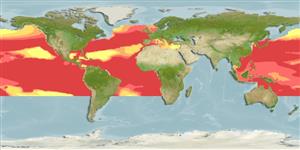Environment: milieu / climate zone / depth range / distribution range
Οικολογία
Θαλασσινό(ά); ωκεανόδρομο(ς) (Ref. 51243); εύρος βάθους 0 - 200 m (Ref. 6517). Subtropical; 60°N - 25°S, 180°W - 180°E
Atlantic, Indian and Pacific: in temperate and tropical waters (Ref. 47377). Western Atlantic: USA and eastern Gulf of Mexico (Ref. 7251). Eastern Atlantic: Bergen, Norway to Madeira and near the Azores, including western Mediterranean; west of Cape Point, South Africa (Ref. 6657). Western Pacific: Japan, Australia, and New Zealand (Ref. 5755). Eastern Pacific: Oregon, USA to Chile (Ref. 2850).
Μέγεθος / Βάρος / Age
Maturity: Lm ? range ? - ? cm
Max length : 200 cm TL αρσενικό/απροσδιόριστο; (Ref. 9314); common length : 152 cm SL αρσενικό/απροσδιόριστο; (Ref. 6517); μεγ. δημοσιευμένο βάρος: 150.0 kg (Ref. 47377)
Μαλακές ραχιαίες ακτίνες (συνολικά): 20; Εδρικές άκανθες 0; Μαλακές εδρικές ακτίνες: 18; Σπόνδυλοι: 22. Absence of dorsal and anal spines and of pelvic fins contribute to streamlining of the body, as does the flat and relatively consolidated opercular spines (Ref. 11017, p. 74).
Oceanic and epipelagic; found near surface or in deep water (Ref. 10821). Apparently solitary (Ref. 9314). Feed mainly on jellyfishes, ctenophores, and other gelatinous planktonic animals (Ref. 2850, 6885). Spawning starts at the end of spring and during the summer (Ref. 9314). Juveniles unlike adults in that the median fins are longer and further forward, the mouth toothed and the body and fins black-spotted (Ref. 6517). Rarely found in markets (Ref. 9314).
Life cycle and mating behavior
Γεννητική Ωρίμανση | Αναπαραγωγή | Γεννοβολία | Αβγά | Γονιμότητα | Προνύμφες
Tyler, J.C., G.D. Johnson, I. Nakamura and B.B. Collette, 1989. Morphology of Luvarus imperialis (Luvaridae), with a phylogenetic analysis of the Acanthuridae (Pisces). Smithsonian Contributions to Zoology, No. 485. Smithsonian Inst. Press, Washington, D.C. 78 p. (Ref. 11017)
IUCN Red List Status (Ref. 130435)
Threat to humans
Harmless
Human uses
αλιεία: περιορισμένης εμπορικότητας
Περισσότερες πληροφορίες
ΑναφορέςΥδατοκαλλιέργειεςΠροφίλ υδατοκαλλιέργειαςΣτελέχοιΓενετικήElectrophoresesΚληρονομικότηταΑσθένειεςΜεταποίησηNutrientsMass conversion
Εργαλεία
Special reports
Download XML
Διαδικτυακές πηγές
Estimates based on models
Preferred temperature (Ref.
123201): 10.1 - 28.2, mean 24.6 °C (based on 1668 cells).
Phylogenetic diversity index (Ref.
82804): PD
50 = 1.5000 [Uniqueness, from 0.5 = low to 2.0 = high].
Bayesian length-weight: a=0.01122 (0.00514 - 0.02450), b=3.04 (2.87 - 3.21), in cm total length, based on all LWR estimates for this body shape (Ref.
93245).
Τροφικό Επίπεδο (Ref.
69278): 3.8 ±0.46 se; based on food items.
Fishing Vulnerability (Ref.
59153): Very high vulnerability (90 of 100).
Nutrients (Ref.
124155): Calcium = 34.8 [20.5, 57.3] mg/100g; Iron = 1.14 [0.70, 1.78] mg/100g; Protein = 19.7 [18.7, 20.6] %; Omega3 = 0.338 [0.212, 0.543] g/100g; Selenium = 37.7 [21.8, 70.6] μg/100g; VitaminA = 6.98 [2.64, 18.68] μg/100g; Zinc = 0.468 [0.336, 0.653] mg/100g (wet weight);
